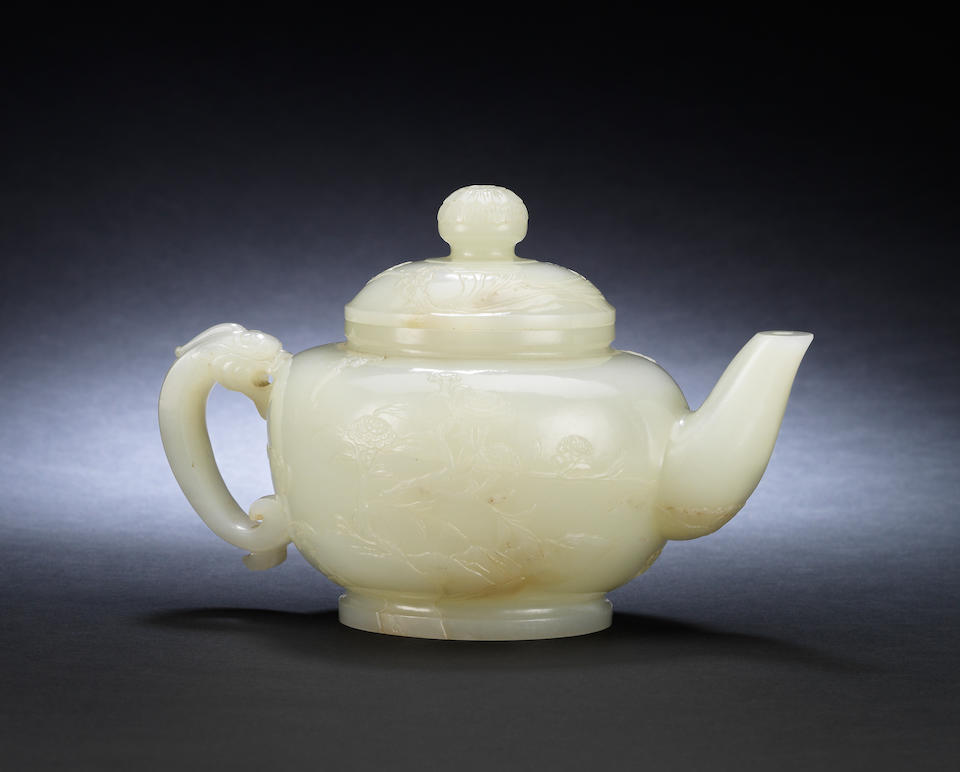A magnificent very pale green jade teapot and cover, 18th-19th century


Lot 50. A magnificent very pale green jade teapot and cover, 18th-19th century; 19.3cm (7 5/8in) wide. Estimate HK$ 600,000-800,000. Sold for HK$ 5,920,000 (€ 703,890). Photo: Bonhams.
The teapot skilfully formed from a fine even-toned very pale green stone, the globular body raised on a low stepped foot, crisply carved in low relief on one side with two bats in flight over sprays of leafy chrysanthemum issuing from rockwork, the other side with a trunk of blossoming prunus with branches spreading over the rounded spout opposite the handle formed as a single-horned mythical beast, the interior expertly hollowed and gently polished, the cover carved with sprays of flowering prunus and narcissus buds on leaves beneath the knop with four rows of radiating petals..
Provenance: An English private collection and thence by descent.
Note: Exquisitely crafted jade vessels such as the present teapot and cover are amongst the most impressive and eye-catching objects in the imperial collections, for the opulent use of the precious jade stone, the exquisite form and accomplished carving. The delicacy of the floral stems reaching across the smoothly carved and evenly toned body is a masterful demonstration of the finesse and sensitivity of the craftsman, exemplary of jade craftsmanship at its peak.
Food and drink vessels made of jade were extremely cherished treasures from as early as the Han dynasty, particularly as they required great expense and wastage of precious jade to produce. M.Wilson in Chinese Jades, London, 2004, p.38, records an anecdote of the Song dynasty ruler, Emperor Huizong, expressing concern about his desire to use jade cups being viewed as extravagance, and a cunning courtier suggesting that such use was an important emblem of his power in comparison to the rival Qidan dynasty. The author also notes that 'of all food and wine vessels, the ewer is the most difficult to make.... [such pieces] would this have been more valuable and rare than porcelain ones...', see ibid., p.44.
The chrysanthemum, juhua 菊花, and plum blossom, meihua 梅花, forms the auspicious synergy of the 'Two Friends of Winter', suihan eryou 歲寒二友. Both motifs symbolises longevity as they remain constant despite the inclement weather. The combination of these two elements can also be read as meishou 眉壽, whereby the plum blossom is a pun for eyebrow, mei 眉; a long eyebrow is considered a sign of longevity. Bats, fu 蝠, can also be read as fu 福, which forms the pun fushou 福壽, which literally translates as 'prosperity and longevity'. Similarly, the narcissus, shuixian 水仙, is a pun for 'immortality', and when combined with the imagery of plum blossoms as carved on the teapot cover, they form the pun tianxian gongshou 天仙供壽, which literally translates as 'May the heavenly immortals honour you with longevity'.
Several examples of white jade teapots and covers dated to the Qing dynasty, including one with related treatment of the mythical beast head handle as the present lot, are illustrated in Compendium of Collections in the Palace Museum: Jade 10: Qing Dynasty, Beijing, 2011, nos.131-135. See also a white jade teapot and cover, Qianlong, from the collection of Andrew K.F.Lee, illustrated in Virtuous Treasures: Chinese Jades for the Scholar's Table, Hong Kong, 2007, Catalogue, no.23.
Compare a related white jade teapot and cover, Qianlong, but of plain exterior, sold at Woolley and Wallis, Salisbury, 18 May 2011, lot 471.
Bonhams. Fine Chinese Ceramics and Works of Art, Hong Kong, 4 June 2015

/https%3A%2F%2Fprofilepics.canalblog.com%2Fprofilepics%2F1%2F0%2F100183.jpg)
/https%3A%2F%2Fstorage.canalblog.com%2F03%2F02%2F119589%2F96711876_o.jpg)
/https%3A%2F%2Fstorage.canalblog.com%2F11%2F31%2F119589%2F94773502_o.jpg)
/https%3A%2F%2Fstorage.canalblog.com%2F20%2F83%2F119589%2F94772815_o.jpg)
/https%3A%2F%2Fstorage.canalblog.com%2F26%2F72%2F119589%2F75604929_o.jpg)
/https%3A%2F%2Fstorage.canalblog.com%2F59%2F60%2F119589%2F26458628_o.jpg)



/http%3A%2F%2Fstorage.canalblog.com%2F13%2F54%2F119589%2F129640437_o.jpg)
/http%3A%2F%2Fstorage.canalblog.com%2F55%2F89%2F119589%2F129639937_o.jpg)
/http%3A%2F%2Fstorage.canalblog.com%2F28%2F56%2F119589%2F129494680_o.jpg)
/http%3A%2F%2Fstorage.canalblog.com%2F42%2F66%2F119589%2F126825470_o.png)